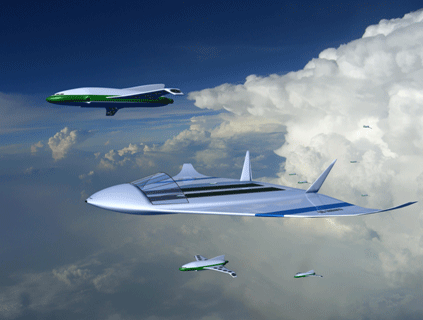Six ideas that were seen as having the most potential included: alternative propulsion, a cruiser/feeder type of long range transport, ground-assisted take-off and landing, personal air travel, advanced airport systems and global air traffic systems.
The first four of these ideas now feature in the latest €80.42 million seven-year research agenda.
The Cruiser/Feeder concept including mid-air refuelling
The concept envisages very large - possibly nuclear-powered - aircraft flying on stable circuitous routes that connect major centres of population. These large cruisers remain airborne for very long periods so that they could be considered to be permanently cycling around their designated route.

They would fly at an economical altitude and speed which would not vary substantially. Linking these cruisers to fixed bases near the population centres would be short range shuttle aircraft designed only to travel from the ground to the an interception with the cruiser and back again.

The feeder airliners would be able to land on or dock with the cruiser for the transfer of passengers and freight, possibly via a kind of pallet system.
New methods of air refuelling would need to be safer and easer to handle than the current system and automation would be required.
The design of the feeder aircraft would also need attention – possibly an advanced super quiet VSTOL aircraft with pre-loaded passenger containers.
Ground-based power sources for take-off and landing
The objective here is to reduce the installed power and systems on the aircraft as a means to reduce weight and fuel consumption.

For take-off, electrical, steam or magnetic devices using oil based, nuclear or solar energy sources could be used. Aircraft ramps, MAGLEV or catapults could be used, using supplementary rocket power.
For landing aircraft weight could be reduced by eliminating the undercarriage with landings on water or on small cars using electro-magnetic fields to position the aircraft, para-foil landings etc.
Personal Air Transport System
Recently developed very light jets - some originating from European companies like Grob and Diamond have led to a new form of air transport, the air taxi - completely different from business aviation.
The Out of the Box team believes that as it presents few fundamentally innovative challenges an effective personal air vehicle can be designed. In fact, this has not been the reason why personal air transport systems have failed to be successfully developed commercially.

They therefore adopted an operational focus here, asking the questions: where can individual aircraft take off and land, what is the environmental impact, what about certification, maintenance, training and what about ownership models, liability issues and infrastructures requirements?

It concluded that operating systems, systems engineering, regulation and control had in fact put off many “inventors” who had come up with air vehicle designs over the years.
Main propulsive power
All energy sources of a quite different nature such as solar and nuclear power should be considered - beyond the advanced and fairly mature gas-turbine concept and fully funded schemes such as fuel cells with energy sources.
Alternative primary and hybrid energy sources would however need to make the most efficient and direct transition from energy source to forward motion.

A range of advanced aeronautic technologies would also need to deal with the output needs for propulsive power and to reconcile the issues of lift, drag, weight and their dynamic interaction.
Basic physical laws will also need to take into consideration the transition of energy from state to state. Conversion means might well involve mechanical and electrical design and the resultant designs would need integrating into the aircraft structure.

A Globalised and Seamless Air Traffic System
Another promising area is the development of a single seamless management system that would replace today’s diverse systems, going well beyond the work of Single European Sky ATM Research.
Featuring a high degree of autonomy allowing individual aircraft to make their own way through controlled airspace, questions remain.

Could autonomy include totally autonomous vehicles and would this enable unmanned aircraft able to fly safely and securely through the air space world-wide?
While modelling and synthetic environments could be used to explore different functional relationships and their implications, advanced IT technologies would be needed if total autonomy is looked for.
Advanced network centric networks will need to support safety oversight so neural network and artificial intelligence would need to be introduced. Advanced display systems would also be needed developed with a human centred approach.
Connecting People with Aircraft
This concerns the system used to process passengers and their baggage from arrival at an airport to being seated in the aircraft ready for departure Queues form and reform at intervals through these multiple processes and the whole takes a considerable time and involves a lot of walking.

The main focus of the concept studies will need to be systems-based but it will be necessary to include considerations of security, immigration processes, baggage routing and handling, ticketing processes so that these can be fully integrated into the system model.
All images courtesy of ACARE/AdeGraaff
More images in the AirSpace gallery of how the future of aviation could look
Source: FlightGlobal.com























